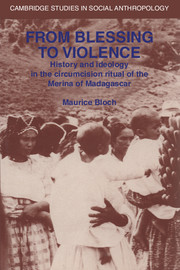Book contents
- Frontmatter
- Contents
- Preface
- 1 The social determination of ritual
- 2 Background politico-religious history of the Merina, 1770–1970
- 3 Background to Merina social organisation and religion
- 4 Description and preliminary analysis of a circumcision ritual
- 5 The symbolism of circumcision
- 6 The myth of the origin of circumcision
- 7 The history of the circumcision
- 8 The circumcision ritual in history: towards a theory of the transformation of ideology
- Notes
- References
- Index
- CAMBRIDGE STUDIES IN SOCIAL ANTHROPOLOGY
8 - The circumcision ritual in history: towards a theory of the transformation of ideology
Published online by Cambridge University Press: 05 June 2012
- Frontmatter
- Contents
- Preface
- 1 The social determination of ritual
- 2 Background politico-religious history of the Merina, 1770–1970
- 3 Background to Merina social organisation and religion
- 4 Description and preliminary analysis of a circumcision ritual
- 5 The symbolism of circumcision
- 6 The myth of the origin of circumcision
- 7 The history of the circumcision
- 8 The circumcision ritual in history: towards a theory of the transformation of ideology
- Notes
- References
- Index
- CAMBRIDGE STUDIES IN SOCIAL ANTHROPOLOGY
Summary
The historical paradox
Despite a patchy and incomplete record, the history of the circumcision ceremony for the period from 1800 to 1970 examined in Chapter 7 is sufficiently clear for there to be little doubt about what happened in the main. The overall pattern that emerges is apparently paradoxical, for we can find in it at once an image of stability and an image of change.
From the formal point of view, the ritual seems to have altered surprisingly little in its symbolic aspects: the ritual acts, the songs, the objects used. On the other hand, if we take a functionalist theoretical perspective, which stresses transformations in the ritual's role in the organisation of the social and economic system, the ritual seems to have changed fundamentally – passing, for example, from a descent-group ritual to a royal ritual and back again. Accompanying this change in the social function of the ritual have been changes that can be called logistic; these follow directly from the functional aspect and concern such matters as the number of people involved, the expense and the length of time given over to the ritual.
Both the formal and the functionalist points of view are reasonable approaches, and both would further our understanding. This makes the fact that each produces such a different image all the more puzzling. In this chapter the two approaches will be brought together in order to explain how the stability of the one and the plasticity of the other can be understood in relation to each other.
- Type
- Chapter
- Information
- From Blessing to ViolenceHistory and Ideology in the Circumcision Ritual of the Merina, pp. 157 - 195Publisher: Cambridge University PressPrint publication year: 1986



